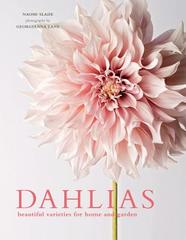Dazzling Dahlias – 39 in a series – Dahlia “King Of The Autumn” via Biodiversity Heritage Library
from Addisonia : colored illustrations and popular descriptions of plants.
DAHLIA “KING OF THE AUTUMN “
Dahlia Garden Hybrid Family Carduacear Thisti,© Family “King of the Autumn,” a variety of Dutch origin, is a good example of the “decorative” class of dahlias, the class that is perhaps the most popular with American dahlia-growers at the present day. The American Dahlia Society defines varieties of this class as having “double flowers, full to the center in early season, flat rather than ball-shaped, with broad, flat, somewhat loosely arranged floral rays with broad points or rounded tips, which are straight or decurved (turned down or back), not incurved, and with margins revolute, if rolled at all.” “Margins revolute,” if pronounced, would lead to placing a variety in the hybrid cactus group, with which the decoratives intergrade, and any pronounced showing of an “open center,” which is an occasional failing of the variety here figured, weakens the line of distinction between the decorative and peony groups. Again, the rounding and deepening of the flower-head and the cupping of the inner floral rays makes a transition to the “hybrid show” type. The decorative type of dahlia has been developed chiefly in Holland, England, and, more recently, in the United States. Most of the numerous varieties of this group now in cultivation in the United States are of domestic origin. The largest-flowered varieties grown at the present time belong in this group, the flower-heads occasionally attaining a diameter of thirteen inches. Many of the varieties have flower- heads that are too large to be represented in natural size on an Addisonia plate, and the desire to show the flowers without reduc- tion in size has led to the selection of one of the smaller-flowered varieties to represent the decorative class. The development of a “fully double” dahlia flower-head from the “single” and “semi-double” forms in which the dahlia was first known in Europe appears to have required a number of years of cultivation and selection. The credit of originating the first “fully double” dahlia has sometimes been given to a Belgian horti- culturist, M. Donckelaar, who is said to have attained this goal in 1814 or 1815. But there appears to be evidence that this result was accomplished as early as 1805 in Kensington Gardens, in I^ondon, and even earlier on the continent (Gard. Chron. III. 35:
An interesting link found among my daily reading

